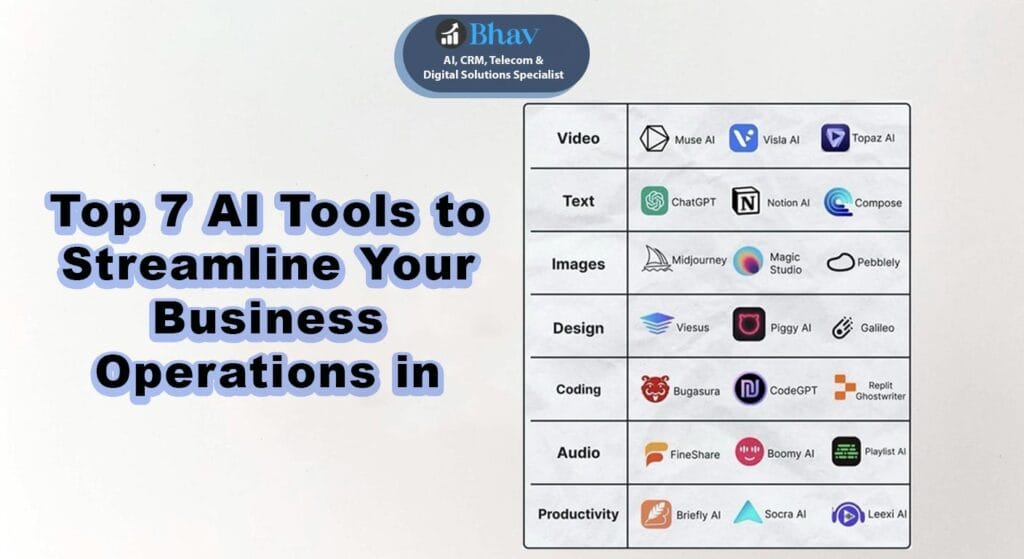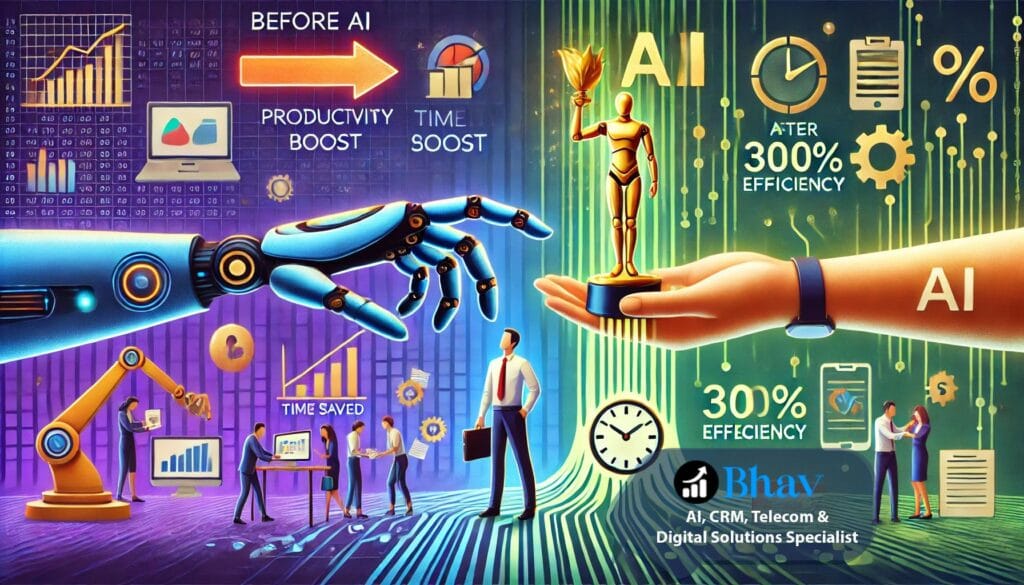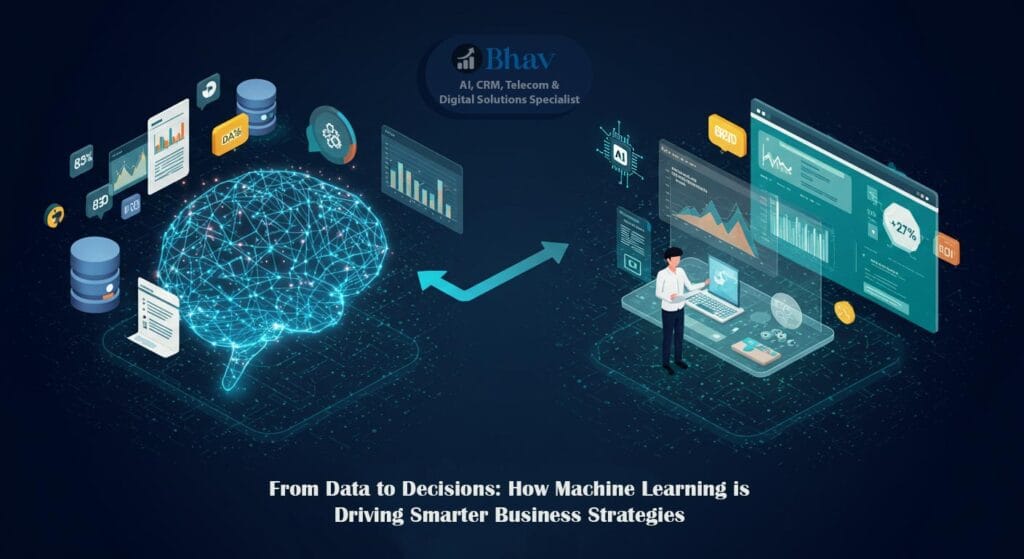
Introduction to AI in Business
In recent years, the integration of artificial intelligence (AI) into business operations has emerged as a pivotal trend, fundamentally altering how enterprises function. AI tools are designed to enhance efficiency and productivity, allowing businesses to streamline various processes, ultimately equipping them to face the challenges of the modern market. The rapid advancement of technology has catalyzed the adoption of AI solutions across diverse sectors, enabling organizations to remain competitive in an increasingly dynamic business environment.
The significance of AI in business cannot be overstated, as it offers unparalleled capabilities in data analysis, customer service, and decision-making. By leveraging machine learning algorithms, businesses can process vast amounts of data rapidly and gain valuable insights that drive strategic initiatives. This leads to informed decisions that can enhance operational efficiency and meet customer demands more effectively. Moreover, AI-powered automation tools help reduce the workload on employees by taking over repetitive tasks, allowing them to focus on higher-level responsibilities that require critical thinking and creativity.
As we advance toward 2025, recent trends indicate that more organizations are recognizing the potential of AI technology. Companies that adopt these tools early are likely to enjoy a competitive edge, as they can better adapt to market changes and customer preferences. Furthermore, the flexibility and scalability of AI applications enable businesses of all sizes to implement solutions tailored to their specific needs, thereby maximizing their return on investment. Overall, the increasing reliance on AI tools signifies a transformative shift in business practices, emphasizing the importance of staying ahead in a rapidly evolving landscape.
Chatbots for Customer Service
AI-powered chatbots have emerged as a transformative solution in enhancing customer service operations for businesses across various sectors. These intelligent programs utilize natural language processing and machine learning algorithms to interact with customers in real-time, providing instantaneous responses to a plethora of inquiries. One of the standout features of chatbots is their 24/7 availability, which ensures that customer support is accessible around the clock, addressing customer concerns outside of traditional business hours.
The advantages of implementing chatbots in customer service are manifold. Primarily, they streamline communication by swiftly handling frequently asked questions, such as inquiries regarding product details, shipping information, or return policies. By automating these interactions, chatbots significantly reduce the workload on human customer service agents, allowing them to focus on more complex queries that require a human touch. This not only enhances employee productivity but also leads to improved customer satisfaction, as responses are delivered with minimal wait times.
Furthermore, chatbots are designed to integrate seamlessly with existing systems, such as Customer Relationship Management (CRM) platforms. This integration enables businesses to unify customer interactions across various channels, whether through websites, social media, or mobile apps. Leveraging data collected from these interactions, chatbots can also offer personalized recommendations, reinforcing customer engagement and loyalty. By analyzing past interactions and preferences, they tailor responses that cater to individual customer needs, thereby providing a customized service experience.
In conclusion, AI-powered chatbots represent a powerful tool for streamlining customer service operations. Their ability to operate continuously, manage routine inquiries efficiently, and integrate with existing systems positions them as essential assets for companies aiming to enhance their customer service strategy in an increasingly digital landscape.
Lead Scoring Tools
Lead scoring tools powered by artificial intelligence have become an invaluable asset for sales teams aiming to enhance their operational efficiency by prioritizing leads. These advanced tools utilize algorithms that analyze various data points—including behavioral patterns, engagement history, and demographic information—to identify potential customers who exhibit the highest likelihood of conversion.
The core functionality of lead scoring tools lies in their ability to systematically assess leads against pre-defined criteria, which can be customized based on specific business objectives. For instance, some AI tools leverage predictive analytics to evaluate past interactions, predicting future behavior based on existing data trends. This capability allows sales professionals to concentrate their efforts on high-priority leads, ultimately streamlining the sales process and increasing conversion rates.
Moreover, integration with existing Customer Relationship Management (CRM) systems is a significant feature of many AI-driven lead scoring tools. This integration facilitates a seamless transfer of data across platforms, allowing for real-time updates and continual refinement of lead scoring models. By synchronizing lead information with CRM tools, sales teams can ensure that they have access to the most relevant insights, enabling them to devise more targeted sales strategies. Furthermore, these tools are designed to adapt with ongoing data collection, continuously improving their scoring algorithms to respond effectively to shifts in buyer behavior.
The impact of implementing AI lead scoring tools in business operations can be transformative. By automating the initial stages of lead assessment, organizations can allocate resources more effectively and increase their overall sales productivity. Consequently, leveraging AI for lead scoring not only optimizes sales efforts but also positions businesses to nurture relationships with high-potential prospects efficiently.
AI Analytics Platforms
Artificial Intelligence (AI) analytics platforms are increasingly vital in transforming the way businesses handle data. These sophisticated tools empower organizations to gather, analyze, and visualize vast amounts of data in a manner that is both efficient and effective. By leveraging advanced algorithms and machine learning techniques, AI analytics platforms can identify patterns and trends across multiple data sources, turning raw data into actionable insights that can drive strategic decision-making.
One of the primary advantages of these platforms lies in their ability to simplify complex data processes. Traditional data analysis often requires extensive manual effort and expertise, which can lead to delays and potential inaccuracies. Conversely, AI analytics tools automate this process, enabling businesses to quickly sift through in-depth datasets, saving both time and resources. Moreover, these tools can facilitate real-time analytics, allowing businesses to respond promptly to emerging trends or issues in their operations.
Integration is another key benefit of AI analytics platforms. Many of these tools are designed to work in tandem with existing business intelligence systems, enhancing data synergy across various departments. This seamless integration ensures that organizations can maintain a holistic view of their operations while leveraging the capabilities of their current technologies. By synthesizing data from disparate sources, AI analytics tools can provide comprehensive insights and foster collaborative decision-making among teams.
The potential of AI analytics platforms extends beyond mere data visualization; they can empower businesses to make informed decisions backed by precise analytics. By proactively identifying opportunities and risks within their data, companies can refine their strategies, ultimately leading to improved operational efficiency and competitive advantage in the marketplace. As the reliance on data-driven insights increases, the role of AI analytics platforms will likely continue to expand in 2025 and beyond.
Workflow Automation Solutions
In recent years, the adoption of AI-powered workflow automation solutions has gained significant traction among businesses seeking to enhance their operational efficiency. These tools are designed to automate repetitive tasks that not only consume valuable time but also increase the potential for human error. By implementing these solutions, companies can streamline their operations across various departments, including accounting, human resources, and more.
One of the primary advantages of workflow automation tools is their ability to reduce manual intervention in routine tasks. For example, in accounting, automated processes can handle invoice generation, payment processing, and financial reporting, thereby freeing up employees to focus on more strategic initiatives. Similarly, in HR, these solutions can manage employee onboarding, payroll processing, and tracking employee performance metrics, ensuring that these processes run smoothly and efficiently.
Moreover, the integration capabilities of AI-driven workflow automation tools with existing project management and collaboration software further enhance their effectiveness. This seamless integration allows teams to synchronize their efforts, ensuring that every member has real-time access to necessary information and updates. By bridging the gap between departments, these systems facilitate improved communication and collaboration, leading to more cohesive project execution.
As businesses increasingly seek innovative solutions to maintain their competitive edge, the implementation of AI-powered workflow automation solutions emerges as a vital strategy. These tools not only bolster productivity but also contribute to a more organized and responsive business environment. The future of business operations is undoubtedly leaning towards these advanced automation tools, solidifying their role in optimizing workflows and elevating overall business performance.
AI-Driven Marketing Tools
In the rapidly evolving landscape of marketing, AI-driven tools have emerged as essential components for businesses aiming to enhance their outreach and engagement. These advanced technologies utilize sophisticated algorithms to analyze vast amounts of consumer data, facilitating the creation of highly personalized marketing campaigns. By leveraging insights derived from consumer behavior, businesses can tailor their messaging to meet individual preferences, thereby improving the overall effectiveness of their marketing efforts.
One of the standout features of AI-driven marketing tools is their ability to integrate seamlessly with existing customer relationship management (CRM) systems. This integration allows for a streamlined approach to managing customer interactions, fostering a more holistic understanding of the customer journey. As businesses gather data across various touchpoints, AI tools can analyze this input to identify patterns and trends, enabling marketers to make informed decisions. Furthermore, this data-driven approach enhances the accuracy of customer segmentation, allowing for targeted communication strategies that resonate with specific audience segments.
Email marketing platforms also benefit from the inclusion of AI technologies. These systems can automate the creation and distribution of personalized email campaigns, optimizing send times and content based on previous consumer interactions. By analyzing metrics such as open rates and click-through rates, AI-driven marketing tools can continuously refine email strategies, increasing engagement and conversion rates. This not only saves time and resources but also enables businesses to foster deeper connections with their audience.
Ultimately, the integration of AI-driven marketing tools signifies a paradigm shift in how businesses approach their marketing strategies. With enhanced capabilities in consumer behavior analysis and campaign personalization, organizations can achieve greater efficiency and effectiveness, positioning themselves for success in a competitive marketplace.
Predictive Maintenance Tools
In the rapidly evolving landscape of business operations, predictive maintenance tools stand out as a crucial component for enhancing efficiency and reducing costs. Designed to anticipate equipment failures before they occur, these AI-powered solutions leverage advanced data analytics to analyze historical and real-time data, allowing organizations to anticipate when maintenance should be performed.
Utilizing machine learning algorithms, predictive maintenance tools continuously monitor key performance indicators from various pieces of equipment. This monitoring includes metrics such as temperature, vibration, and operational loads, which are instrumental in identifying patterns indicative of potential failures. By accurately foreseeing issues, businesses can initiate maintenance at the optimal time, significantly minimizing downtime and extending the lifespan of their assets.
One of the primary advantages of predictive maintenance tools is their integration capability with existing enterprise management systems. This seamless connection enables companies to incorporate predictive insights into their overall operational strategy, ensuring that maintenance schedules align with production goals. By integrating these tools into their frameworks, businesses can streamline workflows, reduce unexpected interruptions, and enhance the performance of their equipment.
Moreover, predictive maintenance not only helps in cutting costs through reduced emergency repairs but also fosters a proactive maintenance culture within an organization. This shift allows maintenance teams to focus on strategic, high-impact tasks rather than being reactive to equipment failures. Consequently, businesses can allocate resources more efficiently and invest in innovation while maintaining operational integrity.
Ultimately, predictive maintenance tools harness the power of AI and data analytics to revolutionize how organizations manage their operations, leading to increased reliability and significant cost savings. This proactive approach is essential for companies looking to stay competitive in the bustling business environment of 2025.
Financial Management AI Tools
In the rapidly evolving landscape of business operations, AI tools focused on financial management are becoming indispensable for organizations aiming to enhance their budgeting, forecasting, and expense tracking processes. These innovative systems utilize advanced algorithms to analyze historical financial data, enabling companies to make informed decisions while optimizing resource allocation.
One of the primary advantages of financial management AI tools is their ability to provide real-time insights into an organization’s financial performance. By integrating seamlessly with existing accounting software and financial systems, these tools can automate essential tasks such as data entry and report generation. This not only saves time but reduces the risk of human error, ultimately leading to more accurate financial reporting. Organizations can leverage these insights to identify trends, develop strategic plans, and allocate budgets effectively.
Moreover, many financial management AI tools come equipped with forecasting capabilities. By analyzing various data sets, they can predict future revenue and expenses, helping businesses to anticipate cash flow needs and adjust their strategies accordingly. This level of foresight allows companies to navigate economic uncertainties with greater confidence, ensuring that they remain financially resilient in challenging environments.
On the expense tracking front, AI tools streamline the process by automatically categorizing transactions and identifying potential areas for cost savings. This not only fosters better financial discipline but also aids in compliance during audits by ensuring accurate records are maintained. As businesses strive to achieve operational efficiency, integrating AI tools into financial management practices proves essential for staying competitive and maximizing profitability.
Conclusion: The Future of AI in Business Operations
As we look toward 2025, it is evident that the integration of artificial intelligence tools into business operations will significantly reshape the landscape of various industries. The AI tools discussed throughout this blog post, such as predictive analytics software, natural language processing systems, and intelligent automation platforms, illustrate how businesses can streamline their operations, enhance decision-making capabilities, and improve customer engagement. The careful selection of these technologies for specific functions can lead to optimized workflows and significant returns on investment.
The future of AI in business operations will undoubtedly be characterized by a rapid evolution of capabilities and applications. Organizations must remain vigilant and proactive in adopting innovations to stay abreast of emerging trends. Some key trends to monitor include the increased personalization of customer experiences through AI-driven data analysis and the growing importance of ethical considerations in AI deployment, addressing issues such as bias and data privacy. Furthermore, as AI tools become more sophisticated, there will be enhanced collaboration between human workers and machines, fostering a new era of productivity.
To remain competitive in a transformative business environment, companies should embrace these AI innovations as strategic assets. Investing in the right technologies not only streamlines operations but also fosters a culture of continual improvement and resilience. By harnessing the full potential of AI tools, businesses can drive sustained growth, adapt to market changes effectively, and ultimately position themselves as leaders in their respective fields. The integration of artificial intelligence is no longer an option but a vital necessity for those aiming to thrive in the future marketplace.
Latest Insights
No Posts Found




